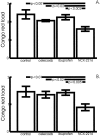Microglial activation and beta -amyloid deposit reduction caused by a nitric oxide-releasing nonsteroidal anti-inflammatory drug in amyloid precursor protein plus presenilin-1 transgenic mice
- PMID: 11896164
- PMCID: PMC6758281
- DOI: 10.1523/JNEUROSCI.22-06-02246.2002
Microglial activation and beta -amyloid deposit reduction caused by a nitric oxide-releasing nonsteroidal anti-inflammatory drug in amyloid precursor protein plus presenilin-1 transgenic mice
Abstract
3-4-(2-Fluoro-alpha-methyl-[1,1'-biphenyl]-4-acetyloxy)-3-methoxyphenyl]-2-propenoic acid 4-nitrooxy butyl ester (NCX-2216), a nitric oxide (NO)-releasing derivative of the cyclooxygenase-1-preferring nonsteroidal anti-inflammatory drug (NSAID) flurbiprofen, dramatically reduced both beta-amyloid (Abeta) loads and Congo red staining in doubly transgenic (Tg) amyloid precursor protein plus presenilin-1 mice when administered at 375 ppm in diet between 7 and 12 months of age. This reduction was associated with a dramatic increase in the number of microglia expressing major histocompatibility complex-II antigen, a marker for microglial activation. In contrast, ibuprofen at 375 ppm in diet caused modest reductions in Abeta load but not Congo red staining, suggesting that the effects of this nonselective NSAID were restricted primarily to nonfibrillar deposits. We detected no effects of the cyclooxygenase-2-selective NSAID celecoxib at 175 ppm on amyloid deposition. In short-term studies of 12-month-old Tg mice, we found that the microglia-activating properties of NCX-2216 (7.5 mg small middle dot kg(-1) small middle dot d(-1), s.c.) were present after 2 weeks of treatment. Microglia were not activated by NCX-2216 in non-Tg mice lacking Abeta deposits, nor were microglia activated in Tg animals by flurbiprofen (5 mg small middle dot kg(-1) small middle dot d(-1)) alone. These data are consistent with the argument that activated microglia can clear Abeta deposits. We conclude that the NO-generating component of NCX-2216 confers biological actions that go beyond those of typical NSAIDs. In conclusion, NCX-2216 is more efficacious than ibuprofen or celecoxib in clearing Abeta deposits from the brains of Tg mice, implying potential benefit in the treatment of Alzheimer's dementia.
Figures









References
-
- Akiyama H, Barger S, Barnum S, Bradt B, Bauer J, Cole GM, Cooper NR, Eikelenboom P, Emmerling M, Fiebich BL, Finch CE, Frautschy S, Griffin WS, Hampel H, Hull M, Landreth G, Lue L, Mrak R, Mackenzie IR, McGeer PL. Inflammation and Alzheimer's disease. Neurobiol Aging. 2000;21:383–421. - PMC - PubMed
-
- Ard MD, Cole GM, Wei J, Mehrle AP, Fratkin JD. Scavenging of Alzheimer's amyloid β-protein by microglia in culture. J Neurosci Res. 1996;43:190–202. - PubMed
-
- Bacskai BJ, Kajdasz ST, Christie RH, Carter C, Games D, Seubert P, Schenk D, Hyman B. Anti-amyloid-β antibodies promote clearance of amyloid-β deposits imaged in vivo in PDAPP mice. Soc Neurosci Abstr. 2000;26:1059.
-
- Bard F, Cannon C, Barbour R, Burke RL, Games D, Grajeda H, Guido T, Hu K, Huang J, Johnson-Wood K, Khan K, Kholodenko D, Lee M, Lieberburg I, Motter R, Nguyen M, Soriano F, Vasquez N, Weiss K, Welch B. Peripherally administered antibodies against amyloid β-peptide enter the central nervous system and reduce pathology in a mouse model of Alzheimer disease. Nat Med. 2000;6:916–919. - PubMed
Publication types
MeSH terms
Substances
Grants and funding
LinkOut - more resources
Full Text Sources
Other Literature Sources
Medical
Molecular Biology Databases
Research Materials
Miscellaneous
